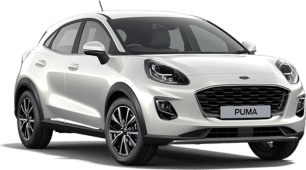In Australia, the Puma plays in the burgeoning 'Light SUV' segment, so goes up against the ageing yet athletic Mazda CX-3 as well as Honda's HR-V, along with more recent challengers like the Hyundai Venue, Kia Stonic, Nissan Juke II, Toyota Yaris Cross and Volkswagen T-Cross. All are ready to pounce on the bestselling Hiroshima crossover.
What every one of these baby SUVs have in common is that they're based on B-segment – or supermini – platforms. However, prices and sizes do blur in this corner of the class, with larger small-car-derived rivals from the 'Small SUV' segment above, led by the Mitsubishi ASX, Kia Seltos, Mazda CX-30 and Hyundai Kona, also in the Ford's crosshairs.
Formidable opponents indeed, and just like that, the first big hurdle appears for the Blue Oval hopeful. Puma is Light SUV-sized but Small SUV-priced, with the entry-level grade kicking off from a tenner under $30,000, and before on-road costs. That's even more expensive than the VW.
This instantly eliminates it from many buyers' radars.
In contrast, a CX-3 Neo Sport starts from just $22,890. But that's with a manual gearbox, plain interior and steel wheels, whereas the Puma includes a ripper turbo engine/auto combo, climate control, a smartphone app that allows for remote vehicle location/ locking/unlocking/starting, voice-activated sat nav, wireless smartphone charging, lane-departure warning and assist, traffic-sign recognition, driver impairment monitor, 17-inch alloys and a leather steering wheel.
Along with other goodies like AEB with pedestrian alert, reverse camera, Bluetooth audio and telephony, Apple CarPlay/Android auto, digital radio, live traffic updates, fuel-saving engine stop/start, auto headlights, rain-sensing wipers, adaptive cornering fog lights, powered folding mirrors, push-button start and puddle lamps, the Puma looks and feels up-spec inside. To match most of that stuff in the CX-3 you'll need a Maxx Sport auto from $26,890.
Rising to the $32,340 ST-Line drops the Puma's ride height by just 2mm (to 164mm), but adds firmer suspension, a body kit, glitzier alloys, sports seats, a 12.3-inch digital instrument cluster, flat-bottomed steering wheel, paddle shifters and racier trim for a racier experience, though it loses the climate control for a manual air-con set-up. Strange. This grade might just be the sweet spot in the Ford's range, though it does sit about $1300 higher than the CX-3 sTouring equivalent.
Finally, the subject of this test, the ST-Line V, scores privacy glass, lashings of chrome, keyless entry/start, leather upholstery, climate control, premium audio, a powered tailgate and 18-inch alloys. All for $35,540, it's about on a par with CX-3 Akari, but lacks the latter's powered driver's seat and heated front cushions, among other items. The Mazda also goes one better with a $2000 AWD option from all mid-level grades up, as well as manual availability.
We recommend the $1500 Park Package, which ushers in adaptive cruise control with full stop/go and lane-centring tech, as well as blind-spot detection and auto parking. Premium paint adds $650, a panoramic roof $2000, roof rails $250 and a black roof $500.
Against compelling alternatives costing less, like the high-flying Seltos Sport+, CX-30 G20 Touring and Toyota C-HR Koba, the ST-Line V struggles to make sense on paper. Can the Puma's cabin and driving experience claw back its obvious price disadvantage?









































 copy.png)











